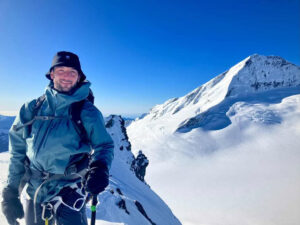Although I’ve done many expeditions to both the North and South Poles, both as an independent traveler and a guide, every fresh trip brings up new gear ideas. There are also old, tried-and-true standards that I have used for years. As I begin the South Pole season, let’s take a look at my gear. Today: boots, socks, gloves, and mitts.
One note: Proper gear is just one aspect of polar travel. Developing skills, planning and logistics, understanding the polar environment, and knowing how to minimize risk are all equally important. If you would like to fast-track your development as a polar traveler, consider hiring an IPGA Polar Expedition Guide.
Handwear

Start at your most extreme needs and work backward: -40˚, windy, Day 20, altitude, fingers already deteriorating.
Use a windproof shell with cinchable gauntlet together with a thick fleece (Icetrek Kelvin mitts pictured) or thick wool inner mitt. (Down is not ideal with ski poles.) Add a thin liner mitt, merino if you have sensitive skin (Devold pictured).
You need to size your mitts to accommodate this liner. You don’t want anything tight or sloppy. Add a glove to this combo and you’re asking for troubled fingers. And never, ever, use a vapor barrier liner, a sure fast-track to frostbite. You need windproof breathability, not waterproofing.
The pull loops on my inner mitts and attached neck lanyard ease the burden of managing my mittens. I can mix up these layers as conditions change. Leather gloves with removable wool inners (Hestra pictured) are great for camp chores or when conditions improve.
Everything is modular for ease of drying. Touch-screen gloves for inside the tent, or as a liner with my Hestras. Or, rarely, for skiing. Outside, I use a capacitive stylus with my phone. It’s silly to risk your fingers for a photo.
In fact, you must be able to work any device with a fully mittened hand. Use the handle of your ski pole to push GPS buttons. Practice makes perfect.
Ski pole grips
I’ve heard mixed reviews on using pogies with light gloves in Antarctica. I’ve never tried them myself. They are not viable on the Arctic Ocean. as I’m often changing from skis to boots and manhandling sleds.
Ski pole straps and techniques are also important. We teach people to use different approaches, depending on the circumstances. It seems to me that the Scandinavian method, below, can place a lot of pressure on the wrist where blood is near the surface.

The Scandinavian method. Photo: Eric Philips
I prefer the typical alpine ski method, below, where veins are not compressed and I can push on the pole with relaxed hands, not forcing blood out of my fingers.

The alpine ski method. Photo: Eric Philips
Regardless, pole straps should be long and adjustable and the pole should have a foam extension below the handle for the lower grip.

Make life easy for your fingers: add extensions
Most of us are familiar with adding extensions to our clothing and tent zippers, but this strategy of making life easier for our fingers should extend to everything.
All metal should be taped or covered (thermoses, tool shafts, fuel bottles, etc.).

The tension buckles and pulls on our tents all have toggles added. It takes hours to thoroughly winterize our tents.

One of the fiddliest bits of kit is the polar bear perimeter fence we use in Svalbard. We can set it up fully mittened, a necessity given the risk to fingers when assembling and dismantling a fence in severe cold.

Boots

This one might start a debate! I’ve been using Baffin boots since my first North Pole expedition in 2002 and have skied over 7,000km with them, mostly their Impact model but others too.
They’re warm and comfortable, and I’ve never had any foot problems or frost damage, but I do have pretty resilient feet. This is their current ski model, the Guide Pro II, for use with three-pin or cable bindings (which are becoming less common these days), or Icetrek’s Flexi bindings. The boots feature a built-in gaiter, removable liner, three layers of footbed/insulation, and lots of other features.
Liners, footbeds, and socks
Although I have poor circulation in my fingers, my toes are more tolerant of the cold. However, I still need to make the right choice of liners, footbeds, and socks.
For my upcoming Antarctica trip, I’m using Intuition Pro Tour liners. They have many models to choose from, but the lace-up Pro Tour is a proven model for long polar trips. They mesh perfectly with my Baffin boots, don’t absorb foot moisture, and are easy to remove for airing. They also come in light, medium, and thick for different temperatures.

The Baffin liner is also good. It is very warm but more prone to blowing out in the heel on long trips and will need a VBL during winter or early spring journeys. You’ll want to provide your own footbed or orthotics. I use this Rottefella Touring insole.

Socks
Many to choose from and only trial and error will get it right for you. And what’s right for you may not be right for the next person.

Start by preemptively taping up any areas on your feet that consistently give you grief. Use a hypoallergenic tape (micropore) followed by sports tape, whatever stays on. For blister mitigation, you might like to try a super thin and smooth liner like the Armaskin but I don’t have much feedback on them.
The second sock is a pair of Wilderness Wear liners I used for 33 days skiing to the South Pole in 2017-18. They are still in great condition — the best sock I ever used on an expedition.
You want anything next to your skin to have a percentage of hard-wearing nylon or lycra, as well as merino for warmth. The blue Wilderness Wear Velo sock is a great option. I use standalone waterproof winter SealSkinz socks as a VBL for North Pole and early spring trips, though not required if using non-absorbent Intuition liners.
The last sock is a thick fleecy Wilderness Wear wool sock to wear with booties in the tent. Lush!
Socks don’t need to be knee-height. That’s a lot of extra sock when layered with shell pants, underlayers, and boots. Wear your sock over your leggings to keep them up but be sure to smooth out any folds.






